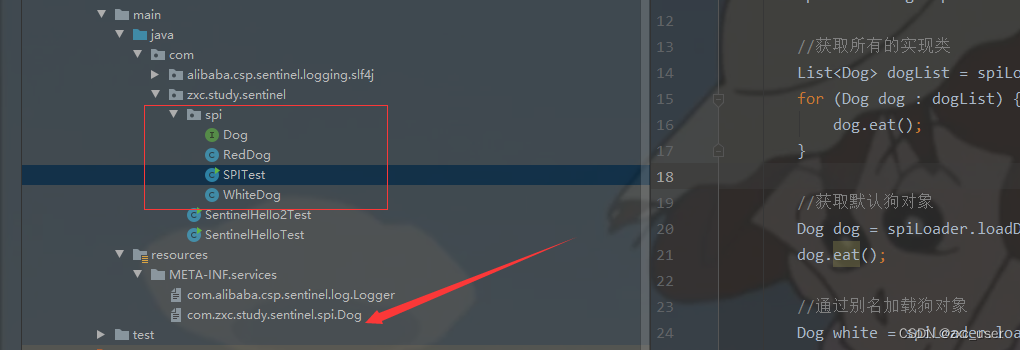之所以要先讲spi机制是因为sentinel后面的一些扩展都需要基于这个机制,所以在这里先大概说下spi的使用与其具体的实现
SPI
SPI 全称Service Provider Interface,
原生Java SPI
JAVA中的SPI机制_清朝程序猿的博客-CSDN博客_java spi
其他细节这里就不说了
Sentinel SPI
Sentinel SPI是对原生的spi进行的一种扩展,提供了缓存功能和排序功能默认实现等,不过相对于dubbo spi还是要差一点,这点以后有机会写dubbo的时候再说一下,不过对于sentinel来说它自己实现的spi也够用了,下面就来稍微看下使用方式与源码的基本解析
使用
定义接口
public interface Dog {
void eat();
}
以下是实现类
/**
* 设置为默认值
*/
@Spi(isDefault = true)
public class RedDog implements Dog {
@Override
public void eat() {
System.out.println("红狗吃饭");
}
}
/**
* 设置别名
*/
@Spi(value = "white", order = -1)
public class WhiteDog implements Dog {
@Override
public void eat() {
System.out.println("白狗吃饭");
}
}
配置文件
sentinel spi机制的配置文件地址是固定,前缀为 com.alibaba.csp.sentinel.spi.SpiLoader#SPI_FILE_PREFIX定义的值,也就是
META-INF/services/,而文件名为接口的全类名,不包含后缀,文件内容以换行分割,为实现类的全类名,如下
文件名为
com.zxc.study.sentinel.spi.Dog
文件内容为
com.zxc.study.sentinel.spi.RedDog
com.zxc.study.sentinel.spi.WhiteDog
spi使用
利用Sentinel提供的SpiLoader进行操作即可,以下为一些测试
public class SPITest {
public static void main(String[] args) {
//加载SpiLoader对象
SpiLoader<Dog> spiLoader = SpiLoader.of(Dog.class);
//获取所有的实现类
List<Dog> dogList = spiLoader.loadInstanceList();
for (Dog dog : dogList) {
dog.eat();
}
//获取默认狗对象
Dog dog = spiLoader.loadDefaultInstance();
dog.eat();
//通过别名加载狗对象
Dog white = spiLoader.loadInstance("white");
white.eat();
//加载第一个实例进行调用,配置文件哪个先放进去就拿拿个
spiLoader.loadFirstInstance().eat();
//可以通过 @spi注解的order进行设置,默认都是0,值越少排的越前面,最优化和最底级别的
spiLoader.loadHighestPriorityInstance().eat();
spiLoader.loadLowestPriorityInstance().eat();
//获取排序后的列表
spiLoader.loadInstanceListSorted();
//其他几个api也都比较简单,这个功能比原生的java spi机制已经要强大很多了,帮我们做了很多事
}
}
最后再看下具体的结构图,其实也是比较简单的

总结:sentinel的spi机制使用还是比较简单的,扩展性也比较强,到时候看到源码你就会看到spi机制的作用了,这种spi机制在dubbo也是用到了,而且是dubbo的核心扩展机制,后面会再说到这个问题,接下来就是要看下实现了,也不是很复杂,目前的话都是以代码来描述的,以后再尝试去画图,理解起来可能更好点
源码分析
spiLoader构建
创建入口: com.alibaba.csp.sentinel.spi.SpiLoader#of
public static <T> SpiLoader<T> of(Class<T> service) {
//基本校验,一看就懂!
AssertUtil.notNull(service, "SPI class cannot be null");
AssertUtil.isTrue(service.isInterface() || Modifier.isAbstract(service.getModifiers()),
"SPI class[" + service.getName() + "] must be interface or abstract class");
//获取全类名
String className = service.getName();
//从获取中获取SpiLoader对象,就是一个全局Map维护的
SpiLoader<T> spiLoader = SPI_LOADER_MAP.get(className);
//没有的话要进行创建,使用双重检索机制处理并发问题,这也是阿里惯用手法!
if (spiLoader == null) {
synchronized (SpiLoader.class) {
spiLoader = SPI_LOADER_MAP.get(className);
if (spiLoader == null) {
//创建并方到缓存中,直接new对象然后放到缓存中
SPI_LOADER_MAP.putIfAbsent(className, new SpiLoader<>(service));
spiLoader = SPI_LOADER_MAP.get(className);
}
}
}
//如果缓存有直接返回,没有则创建
return spiLoader;
}
这段逻辑还是比较简单的,除了双重检锁机制可能稍微复杂点,其他的没有啥,加锁是为了并发问题处理spiLoader的具体操作
spiLoader对象获取实例的操作,也不是很复杂,除了获取对象的那部分代码,其他的逻辑还是比较简单的
首先先看下load方法,这也是核心加载方法,这个看完了,其他的是比较简单的
//使用juc包下原子类控制只加载一次
if (!loaded.compareAndSet(false, true)) {
return;
}
//拼接文件全类名, META-INF/services/com.zxc.study.sentinel.spi.Dog
String fullFileName = SPI_FILE_PREFIX + service.getName();
//获取类加载器逻辑...
ClassLoader classLoader;
if (SentinelConfig.shouldUseContextClassloader()) {
classLoader = Thread.currentThread().getContextClassLoader();
} else {
classLoader = service.getClassLoader();
}
if (classLoader == null) {
classLoader = ClassLoader.getSystemClassLoader();
}
//加载资源
Enumeration<URL> urls = null;
try {
urls = classLoader.getResources(fullFileName);
} catch (IOException e) {
fail("Error locating SPI configuration file, filename=" + fullFileName + ", classloader=" + classLoader, e);
}
if (urls == null || !urls.hasMoreElements()) {
RecordLog.warn("No SPI configuration file, filename=" + fullFileName + ", classloader=" + classLoader);
return;
}
//循环处理文件,可能有多个,这里也是体现扩展的地方
//你可能引用的是sentinel的jar包,他里面会有这个文件,然后你也可以在自己项目对应的文件下配置该文件
while (urls.hasMoreElements()) {
URL url = urls.nextElement();
InputStream in = null;
BufferedReader br = null;
try {
in = url.openStream();
br = new BufferedReader(new InputStreamReader(in, StandardCharsets.UTF_8));
String line;
while ((line = br.readLine()) != null) {
if (StringUtil.isBlank(line)) {
// Skip blank line
continue;
}
line = line.trim();
int commentIndex = line.indexOf("#");
if (commentIndex == 0) {
// Skip comment line
continue;
}
if (commentIndex > 0) {
line = line.substring(0, commentIndex);
}
line = line.trim();
Class<S> clazz = null;
try {
clazz = (Class<S>) Class.forName(line, false, classLoader);
} catch (ClassNotFoundException e) {
fail("class " + line + " not found", e);
}
if (!service.isAssignableFrom(clazz)) {
fail("class " + clazz.getName() + "is not subtype of " + service.getName() + ",SPI configuration file=" + fullFileName);
}
//上面是解析一行行的数据,然后反射加载类...
classList.add(clazz);
//获取spi注解,这个是标记在实现类上的
Spi spi = clazz.getAnnotation(Spi.class);
//获取别名
String aliasName = spi == null || "".equals(spi.value()) ? clazz.getName() : spi.value();
if (classMap.containsKey(aliasName)) {
Class<? extends S> existClass = classMap.get(aliasName);
fail("Found repeat alias name for " + clazz.getName() + " and "
+ existClass.getName() + ",SPI configuration file=" + fullFileName);
}
classMap.put(aliasName, clazz);
//是否有别名,有的话则进行设置
if (spi != null && spi.isDefault()) {
//别名只能有一个,多个时则报错
if (defaultClass != null) {
fail("Found more than one default Provider, SPI configuration file=" + fullFileName);
}
defaultClass = clazz;
}
RecordLog.info("[SpiLoader] Found SPI implementation for SPI {}, provider={}, aliasName={}"
+ ", isSingleton={}, isDefault={}, order={}",
service.getName(), line, aliasName
, spi == null ? true : spi.isSingleton()
, spi == null ? false : spi.isDefault()
, spi == null ? 0 : spi.order());
}
} catch (IOException e) {
fail("error reading SPI configuration file", e);
} finally {
closeResources(in, br);
}
}
sortedClassList.addAll(classList);
//进行排序,默认顺序为0,值越小排的越前
Collections.sort(sortedClassList, new Comparator<Class<? extends S>>() {
@Override
public int compare(Class<? extends S> o1, Class<? extends S> o2) {
Spi spi1 = o1.getAnnotation(Spi.class);
int order1 = spi1 == null ? 0 : spi1.order();
Spi spi2 = o2.getAnnotation(Spi.class);
int order2 = spi2 == null ? 0 : spi2.order();
return Integer.compare(order1, order2);
}
});
}
再看看其他的方法
1. 加载全部实例的方法 com.alibaba.csp.sentinel.spi.SpiLoader#loadInstanceList
public List<S> loadInstanceList() {
//加载对象,如果加载过则不会再加载了
load();
//根据文件配置顺序实现化对象出来
return createInstanceList(classList);
}
再到里面去看
private List<S> createInstanceList(List<Class<? extends S>> clazzList) {
//为空则返回
if (clazzList == null || clazzList.size() == 0) {
return Collections.emptyList();
}
List<S> instances = new ArrayList<>(clazzList.size());
//循环创建实例
for (Class<? extends S> clazz : clazzList) {
//创建实例
S instance = createInstance(clazz);
instances.add(instance);
}
return instances;
}
private S createInstance(Class<? extends S> clazz) {
//获取注解
Spi spi = clazz.getAnnotation(Spi.class);
//标记是否为单例,默认是单例的
boolean singleton = true;
if (spi != null) {
singleton = spi.isSingleton();
}
//创建实例
return createInstance(clazz, singleton);
}
private S createInstance(Class<? extends S> clazz, boolean singleton) {
S instance = null;
try {
//如果是单例的话仍然使用双重检锁机制解决并发问题
if (singleton) {
instance = singletonMap.get(clazz.getName());
if (instance == null) {
synchronized (this) {
instance = singletonMap.get(clazz.getName());
if (instance == null) {
//实例化对象并放到缓存中
instance = service.cast(clazz.newInstance());
singletonMap.put(clazz.getName(), instance);
}
}
}
} else {
//非单例直接实例化对象
instance = service.cast(clazz.newInstance());
}
} catch (Throwable e) {
fail(clazz.getName() + " could not be instantiated");
}
return instance;
}
代码看着有点多,但其实很容易理解
2. 加载默认对象 : com.alibaba.csp.sentinel.spi.SpiLoader#loadDefaultInstance
public S loadDefaultInstance() {
//仍然是要加载,如果有就不再次加载了
load();
//没有默认class直接返回空
if (defaultClass == null) {
return null;
}
//有的化使用通用方法加载对象,又走到上面的逻辑了
return createInstance(defaultClass);
}
3. 根据别名获取对象: com.alibaba.csp.sentinel.spi.SpiLoader#loadInstance(aliasName)
public S loadInstance(String aliasName) {
AssertUtil.notEmpty(aliasName, "aliasName cannot be empty");
load();
//之前load的时候已经把别名和对象放在对应的map里面了
Class<? extends S> clazz = classMap.get(aliasName);
if (clazz == null) {
fail("no Provider class's aliasName is " + aliasName);
}
//创建对象,,这里idea有个显示bug,其实上面fail()方法里面已经抛异常了,但是这里感知不到,所以会提示说clazz不能为null
return createInstance(clazz);
}
4. 获取第一个实例,根据你配置文件的进行拿取
public S loadFirstInstance() {
//加载
load();
if (classList.size() == 0) {
return null;
}
//获取第一个并返回,你配置文件怎么配的就拿哪个
Class<? extends S> serviceClass = classList.get(0);
S instance = createInstance(serviceClass);
return instance;
}
5. 获取优先级最高的 com.alibaba.csp.sentinel.spi.SpiLoader#loadHighestPriorityInstance
//加载
load();
if (sortedClassList.size() == 0) {
return null;
}
//从排好序的获取最考前的,排序是@Spi注解的order属性定义的,越小越考前
Class<? extends S> highestClass = sortedClassList.get(0);
return createInstance(highestClass);
}
6. 获取优先级最低的,跟上面反着来...
public S loadLowestPriorityInstance() {
load();
if (sortedClassList.size() == 0) {
return null;
}
Class<? extends S> lowestClass = sortedClassList.get(sortedClassList.size() - 1);
return createInstance(lowestClass);
}
7. 获取排序的实例列表
public List<S> loadInstanceListSorted() {
//加载
load();
//把维护好排好序的放进去创建实例...
return createInstanceList(sortedClassList);
}
其他的就不说了,有兴趣可以自己看看
主要逻辑都在load()方法里面,其他的方法实现其实很简单,就是在对一个List进行操作,拿第一个,最后一个,等等,估计你一看就懂了.....
好了,这篇就说到这里,这个spi机制在后面会有使用,而且我们对sentinel的扩展有一部分就是基于这个机制进行扩展的..
最后
以上就是想人陪饼干最近收集整理的关于第二篇:Sentinel之SPI机制使用与源码分析SPISentinel SPI的全部内容,更多相关第二篇:Sentinel之SPI机制使用与源码分析SPISentinel内容请搜索靠谱客的其他文章。








发表评论 取消回复